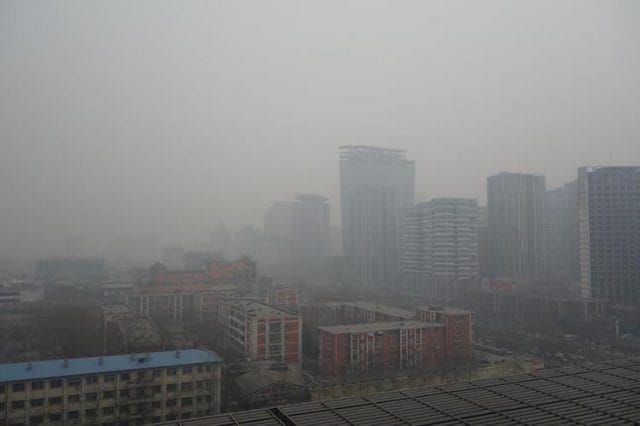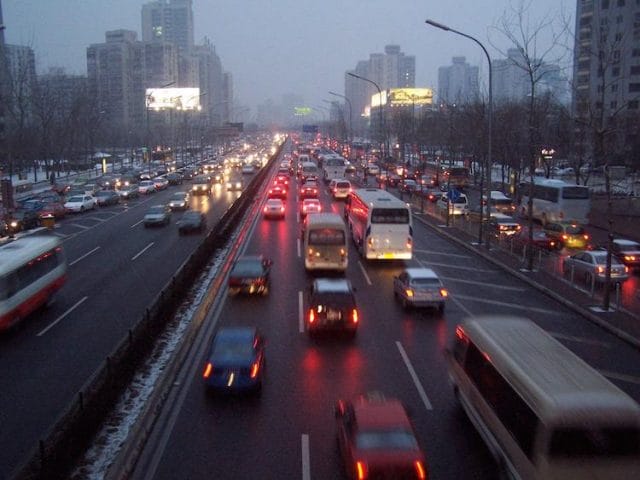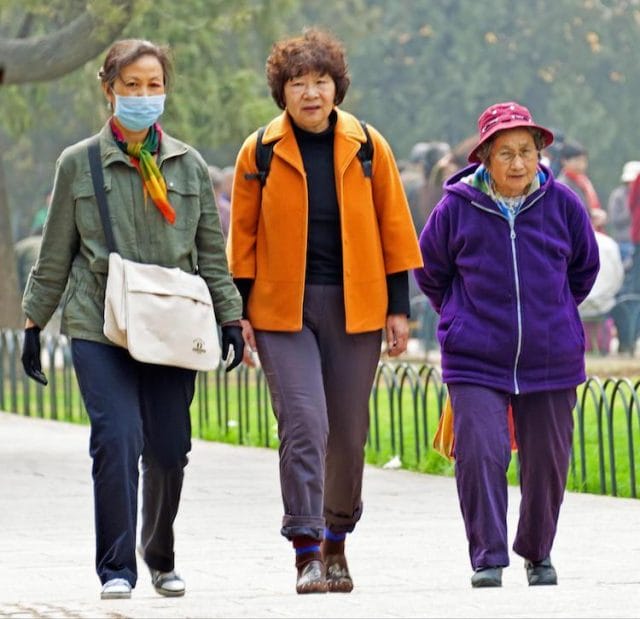
This post was written by Josh Freedman, an American writer and researcher living in Beijing, for the Priceonomics Freelance Writing Program (Photo: Kentaro IEMOTO)
***
In early December, anticipating a spell of bad air, Beijing issued its first-ever pollution ‘red alert’. Officials canceled classes for three days, pulled half of the cars off the road, halted outdoor construction, and shut down street side barbecue stalls.
“All we can do is wait for the wind to come” to sweep the pollution out, newspaper headlines in the capital read.
The World Health Organization recommends a daily maximum exposure of 25 micrograms per cubic meter of PM2.5 (air pollution particles smaller than 2.5 micrometers in diameter that are more dangerous to human health.) Beijing’s annual average in 2014 exceeded 100 micrograms per cubic meter, according to data from the US embassy. Bad pollution in China isn’t new. But the Chinese government’s response this time is a big departure from the past, in which, according to them, pollution either was not important or did not really exist.
Starting earlier this year, China’s top leaders vowed to make environmental improvement a top priority, pushing the importance of an ‘ecological civilization’ alongside economic growth. Since then, they’ve integrated sustainability into development plans, public speeches, and policy documents, and penalized lower-level authorities who fail to crack down on pollution. Under the new economic normal of slower growth, high-ranking officials see cleaning up the environment as a battle they should – and need to – win.
Yet despite these efforts, terrible pollution continues to suffocate Beijing and other parts of the country. (At the time of writing this, the pollutant levels in Beijing are again literally off-the-charts: the US Embassy in Beijing calls it ‘Beyond Index’ or ‘Crazy Bad’; I call it ‘Unventilated Smoking Parlor Making Wood-Fired Pizzas Bad’). Even the most optimistic reformers say clean air is many years out, and dealing with rampant water and soil pollution will take even longer.
China is famous for being able to execute large-scale changes that few governments could. China’s leaders have few explicit checks on their power, which allowed them to completely retool Beijing for the 2008 Olympics and build a subway system longer than New York’s in less than 10 years. Beijing, the nation’s capital, is seen as a showcase city to prove China’s development to the rest of the world. So why is it so hard to for China to achieve its blue-sky goals?
***

Temporarily clear skies over the Forbidden City in Beijing (Jack Versloot)
When the central government really wants to make the skies blue, it can – but so far only at an extraordinary cost.
To ensure pollution-free skies during September’s military parade – highlights of which are still playing on loop on Beijing’s subways – the government shut down or scaled back more than 10,000 factories and 9,000 construction sites in Beijing and the surrounding areas. Not only did the local economy suffer from the shutdown, including the poorer areas that surround the capital, but dispatching monitoring and enforcement teams was a monumental endeavor.
A more sustainable solution to pollution in China is tied to broader economic and political change. China is still grappling with the effects of the radical economic changes of the last thirty years, in which economic reform brought rapid but highly uneven growth. In many ways, the forces that pollute are deeply ingrained in what makes the system run.
Although it may seem monolithic from the outside, in practice China’s governance is defined by the complicated and often combative relationship between central officials and lower authorities. The central government takes in most tax revenue and provides broad mandates, while provincial, municipal, and lower levels of government are responsible for designing, executing, and implementing policies.
What the central government wants, or claims to want, is not necessarily what takes place in practice. This makes cleaning up pollution a much more complicated task than it first appears.
The Usual Suspects: Coal and Traffic

A traffic jam in Beijing (Kallgan)
Burning coal is the largest single source of China’s pollution. According to estimates by Greenpeace, coal consumption is responsible for up to half of China’s PM2.5.
Efforts to crack down on coal have met mixed success. Top-down policies have been effective in moving coal-fired power plants away from major cities, and replacing smaller, less efficient plants with larger ones. Downtown Beijing, for example, no longer uses coal to heat homes. Around the periphery, however, small-scale coal burning continues – often using lower-quality coal that causes worse pollution.
Building new coal plants — even though central policies discourage it — is still a way for local officials to boost short-term growth, especially as China’s coal country faces a bleak economic picture. Investment in coal plants increased, rather than decreased, in 2015. Falling demand, both in China and around the world, has also contributed to record-low coal prices. Coal is now much cheaper than renewable energy, even though China has built lots of wind and solar. As China’s overall energy demand is set to decline because of the slowing economy and decline of heavy industry, the possibility of the electricity grid favoring coal over renewables could slow down progress in reducing emissions.
It’s also worth looking at cars and trucks, which are everywhere in major, congested, traffic-filled cities like Beijing. Large delivery trucks are often huge emitters, even if they claim to be up to standard. Roadside checks found that 80-90 percent of heavy trucks had fake approvals, Li Kunsheng, head of vehicle emissions enforcement in the Beijing Environmental Protection Bureau, said at a recent conference. But upgrading so many vehicles is expensive and will jeopardize local economic interests.
Hebei: The Pesky Neighbor

The province of Hebei surrounds Beijing
The growth that transformed downtown Beijing into a hub of skyscrapers and traffic is still uneven, making the environmental cleanup challenge greater. Cities, and Beijing in particular, have enjoyed a favored position in China’s development. Under the planned economy, Beijing became a center of profitable heavy industry, with surrounding areas playing only supporting roles.
As Beijing expanded, including playing host to the 2008 Olympics, factories were moved out of the city. Many ended up next door in Hebei province, which borders Beijing on three-and-a-half sides. Hebei, which is much poorer than the capital, now produces a significant chunk of the entire world’s steel and is home to seven of the 10 most polluted cities in China. Much of that smog ends up in Beijing: for Beijing to clean its air, Hebei and other close provinces have to as well.
Although Beijing’s development can compare with major urban centers across the world, areas just an hour outside of downtown are still transitioning into livelihoods based on greater energy consumption, rather than less. For all of the rhetoric about a new ‘ecological civilization’, areas struggling economically have plenty of reasons to be more concerned about boosting the economy than cutting emissions. Look no further than employment: Last year, in an interview with Global Times, a state-run newspaper, the governor of Hebei vowed to cut pollution but said that decreasing steel production by 10 million tons would result in ‘thousands of people’ losing their jobs.
The project of cleaning the air in both Beijing and its neighboring regions is an attempt to fix the problems of both a developed and a developing country at the same time.
This is clear in how pollution not only comes from industrialization itself, but what it has left behind. According to official media reports, the wave of pollution that shrouded Beijing in haze during the October national holidays came from peasant farmers burning straw after the harvest. This practice, although technically illegal, is a cheaper way to get rid of unwanted leftovers in the field. “Shifts in the energy structure of the Chinese countryside have reduced the need for straw as a source of fuel for households,” writes Ma Tianjie in chinadialogue, which covers environmental news in China. “On the other hand, the loss of rural labour to the cities has made manual collection of the remaining stalks uneconomic for women and elders left to take care of the fields.”
As China tries again to reorient its economic strategy, it has still not fully solved the remaining pieces of the last transition. How can Beijing embrace green development, while Hebei is still searching for a leg up in the market economy?
Another New Normal: The Masses Want to Breathe, Too

The variability of Beijing air quality (Bobak)
Less than a week after its first crackdown, Beijing officials called for another red alert. For three more days, construction was halted, traffic was magically improved, and every person in Beijing, including me, had to find an alternative to street stall barbecue to satisfy our late-night cravings.
As an American living in China, people back home always ask how bad Beijing’s pollution actually is. I rarely give the same answer twice. If you catch me during a spell of Beijing’s smoggiest days, in which the skyscrapers above are barely visible through a grayish haze, I will tell you that it is terrible — unlivable, or something close. If you happen to find me after the wind has swept through and left behind a brilliant blue sky, I’ll probably tell you that, yes, there are some bad days, but overall it’s not as bad as people tell you.
I am not trying to sanitize or diminish whatever is happening to my lungs, or exaggerate how depressing it can be when everything is bleak and gray. We all have an incredible ability to be unable to remember the negative; we forget the past and refocus on our immediate surroundings. In the words of the writer Rebecca Solnit, “The present rearranges the past.” It is not a mental trick so much as a natural coping mechanism. Watching my own psyche shift effortlessly from one view to the other makes it easier to understand how billions of people — if you include other smog-shrouded areas of South and Southeast Asia that have worse pollution than Beijing — can cope.
Life under the dome is frustrating, but when the dome clears, it leaves behind a city of people who have no choice but to brush off the pollution and try to build a livable existence.
But despite this ability to carry on, China’s pollution has not gone unnoticed. Foreign residents have always been eager to complain about the pollution, but China’s own urban population is starting to make noise as well. Residents of China’s flagship city are now hinting at their own frustration as expectations of a higher standard of living continue to grow.
Beijing’s red alert frenzy is, many suggest, related to increasing public pressure to cut down on the city’s haze from both top and bottom. Growing knowledge of the health hazards of pollution, and its obvious visibility, have made it increasingly difficult for officials to downplay the issue. City officials who fail to respond are subject to heavy popular criticism. The mayor of Beijing even promised to cut off his head and present it for all to see if he could not follow through on his pledge to reduce the capital’s PM2.5 levels by a quarter by 2017.
Just a few years ago, anyone can tell you, few people in China — even in cosmopolitan areas of Beijing — recognized pollution as anything more than fog. Now, heavy-duty pollution masks are a common sight in Beijing, and not just among health-obsessed foreigners. Xiaomi, a leading Chinese phone brand and distributor of hip gadgets, recently started to sell a home air filter. It sold out within minutes. Friends of mine who had long resisted buying air filters are finally taking the plunge, even if their families and friends outside of the big city remain unconvinced.

A woman in a pollution mask in Beijing (Daniel Case)
Last month, biking down East 4th Street Alley Number 10, a major thoroughfare in downtown Beijing, I passed a woman who had spread out a blanket to sell small trinkets and goods. On street corners and in subway corridors around the city, these vendors can be found selling winter gear— scarves, socks, gloves — and small trinkets representing the latest fads, from cat ears to strands of fake grass that people stick in their hair to look ‘cute’, or, at the very least, to fit in with a row of hedges. This day, the vendor had another item she was selling: 3M pollution masks.
I cannot say whether it has fully caught on. But protection from the smog appears to have at least surpassed looking like a plant. And while most fashion fads in China come and go very quickly; this one seems likely to stick around.
***
In our next post, we use time-use data to investigate how the life of a 20-something today is different from the life of a 20-something a decade ago. To get notified when we post it → join our email list.
This post was written by guest writer Josh Freedman for the Priceonomics Freelance Writing Program. You can follow him on Twitter @freedman_josh.



